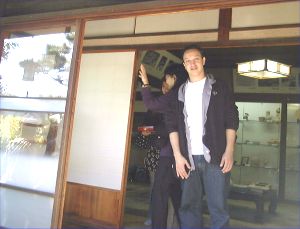 |
 |
| 宝泉寺と窯垣の小径 Hosenji temple and Kamagaki-no-komichi path [Photos taken on Nov 13, 2004] |
| 参考ウェブページReference web pages |
| 窯垣の小径、本業窯、陶祖公園、宝泉寺 Kamagaki-no-komichi, Hongyo-gama, Toso park and Housenji-temple (No.1/2) |
| 窯垣の小径、本業窯、陶祖公園、宝泉寺 Kamagaki-no-komichi, Hongyo-gama, Toso park and Housenji-temple (No.2/2) |
| コース: 「瀬戸公園」入口 → 宝泉寺 → 窯垣の小径 → 窯垣の小径資料館 2004年11月13日、ビジターである名古屋学院大学と名古屋大学への留学生3名 (アメリカ、オーストラリア及びカナダ)、ガイド参加者及び「ボラみみより情報局」の方並びに 瀬戸英語ボランティアグループのメンバーとで、瀬戸市の宝泉寺を訪れ、窯垣の小径 界隈を歩きました。 「窯垣の小径資料館」へ行く途中に予定外の、「窯垣の小径ギャラリー」があったので、 ちょっと立ちよりました。道すがら、窯垣の材料となっている窯道具やムクノキ(椋の木) をビジターへ説明しました。 宝泉寺と曹洞宗について以下に簡単に要約します。 その他については上記参考ウェブページを参照願います。 宝泉寺は曹洞宗の寺院です。宝泉寺の歴史は次のように推定。 1252年 宝泉寺が、霊水山神宮寺(備考1)として創立。 1647年 雲興寺15世興南和尚により曹洞宗大唱山宝泉寺として創建。 当時の本尊は延命地蔵菩薩像;現在は釈迦牟尼仏 1933年 諸堂が一新され、本尊が現在の釈迦牟尼仏に改め られました。 毎年11月8・12日には薬師如来の縁日が催され’お薬師さん’と呼ばれ、 地元の方をはじめ多くの参詣客で賑わいます。 備考:出典 「日本の伝統文化 −日本文化キーワード」 1 神宮寺 神社に付属して建てられた寺院。神仏習合思想の現れで、社僧(別当)が 神社の祭祀(さいし)を仏式で挙行した。1868年(明治1)の神仏分離令により 廃絶または分離。宮寺。別当寺。神護寺。神宮院。神願寺。 2 神仏習合 日本では昔から、外来の仏教と民俗宗教である神道が、時には合成されたり して共存してきました。仏教は有神教ではなく、一方神道は自然崇拝を主として いるため、合成されても矛盾が生じなかった。 これを神仏習合という。 6世紀の仏教伝来以降、仏教寺院の建設を神社が補助するなど、この傾向は 長く続いた。日本が近代国家として発足するとき(1868年)に政府が神道強化の 方針をとったため神仏習合が禁止されたこともあったが、現在でも、同一家庭内 に仏壇と神棚の両方が置かれていたり、結婚式は神式で挙げるのに葬式は仏式 で行うといったことが、ごくふつうに行われてる。 3 曹洞宗 (中日新聞の2004年10月31日「中日サンデー版」より要約) 道元が栄西の系譜で臨済宗を学んだが、政治権力との接近を望まず、 座禅に打ち込む為、1244年に越前に永平寺を開いた。ひたすら、座禅に生き、 自分の中の仏性を見出し、この姿こそ仏だと信じることを目指す。 曹洞宗は仏教の1部派。 仏教はインドで2,500年ほど前に釈迦(尊称は「釈尊」)によってその教えが 説かれた。 釈迦の教えをめぐる理解の相違から多くの部派に分裂した。 日本の仏教は大乗仏教(釈迦の入滅後400−500年後に、民衆すべてが 救われるとする)である。 2002年末現在宗教法人が7万4940ある。 寺院の数は浄土系仏教が2万9512、信者数1952万人と最も多い。 禅系仏教は2番目に寺院数が多く2万915。但し、信者数は少なく、335万人。 Course: "Seto Kouen" park → Hosenji temple → "Kamagaki-no-komichi" path →"Kamagaki-no-komichi museum" On November 13, 2004, visitors (three foreign students to Nagoya Gakuin University and Nagoya University from the United States, Australia, and Canada) , guide participants, a person from "Vola-mimiyori-jyouhoukyoku" and the Seto English volunteer group's member visited the Hosen temple of Seto-city, and walked around "Kamagaki-no-komichi" path. On the way to "Kamagaki-no-komichi museum", we found out unexpected gallery called "Kamagaki-no-komichi gallery ". So, we dropped in there for a little while. While walking toward "Kamagaki-no-komichi museum", we explained components of "Kamagaki" (which is literally translated into "Kiln fence"). That is to say, tools for firing ceramics were cracked when using repeatedly at high temperature of about 1200 through 1300℃ inside kilns. These obsolete tools were used as material for fences. This is environmentally friendly. Hosenji temple and Soto Zen sect of Buddhism are summarized below. As for those other than the Hosenji temple and the Soto Zen sect,please see the above reference web pages. Hosenji temple belongs to Soto Zen sect of Buddhism. History of this temple are presumed as follows: 1252: This temple was established as Reisuizan-Jinguji (literally translated to miraculous fountain mountain Shinto shrine temple). (See Remark 1) 1647: This temple was established as Hosenji temple by Mr. Konan, 15th priest of Unkoji temple. The principal image at that time is said to have been Enmei-Jizo-Bosatsu (literally translated to 'Life-prolonging guardian deity of children Bodhisattva or Buddhist saint"). 1933: The main building and the others have been renewed and the principal image has been revised to Shakyamuni (or Gautama or the Buddha). On November 8 and 12 every year, a festival day of the Healing Buddha is hold. The festival is called 'Oyakushi-san' personally and crowded with people from local people and many visitors to Hosenj temple. Remarks: Quoted from "Traditional Japan - Key Aspects of Japan" 1 Jinguji Jinguji ("Jingu" means Shinto shrine, and "ji" means temple) temples were built, attaching to the shrine. In favor of thought,"Shinbutsu-shugo" (See Remark 2), priests performed religious service of a shrine according to Buddhist rites. The temples were abolished or separated by government order of separation of Shinto-and-Buddhist-deities in 1868. 2 Shinbutsu-shugo (Shinto-Buddhist synthesis) In Japan long ago, Buddhism, which came from abroad, and Shinto, which is a folk religion, occasionally came together in a synthesis. Because Buddhism is not a theistic doctrine and Shinto principally worships nature, there were no contradictions in synthesizing them. This is called shinbutsu-shugo. This tendency continued for a long time after Buddhism was introduced in the sixth century as seen in Shinto shrines supporting in building Buddhist temples . When Japan began to function as a modern nation state in 1868, shinbutsu-shugo was prohibited because the government set a policy of strengthening Shinto. But now, it is quite commonly practiced to set up both Buddhist family altars and Shinto family altars in the same house, or to have weddings with Shinto rituals and funerals with Buddhist rituals. 3 Soto Zen sect of Buddhism ,An instruction of Buddhismwas was explained by Gautama Buddha in India about 2,500 years ago. The Soto Zen sect has been established by Dogen in Japan in 13th century. |
| 窯垣の小径資料館 "Kamagaki-no-komichi museum" |
 |
| 洞本業窯
(瀬戸市の有形文化財) "Hora-Hongyogama" climbing kiln with 4 chambers (Tangible cultural properties of Seto City) |
 |